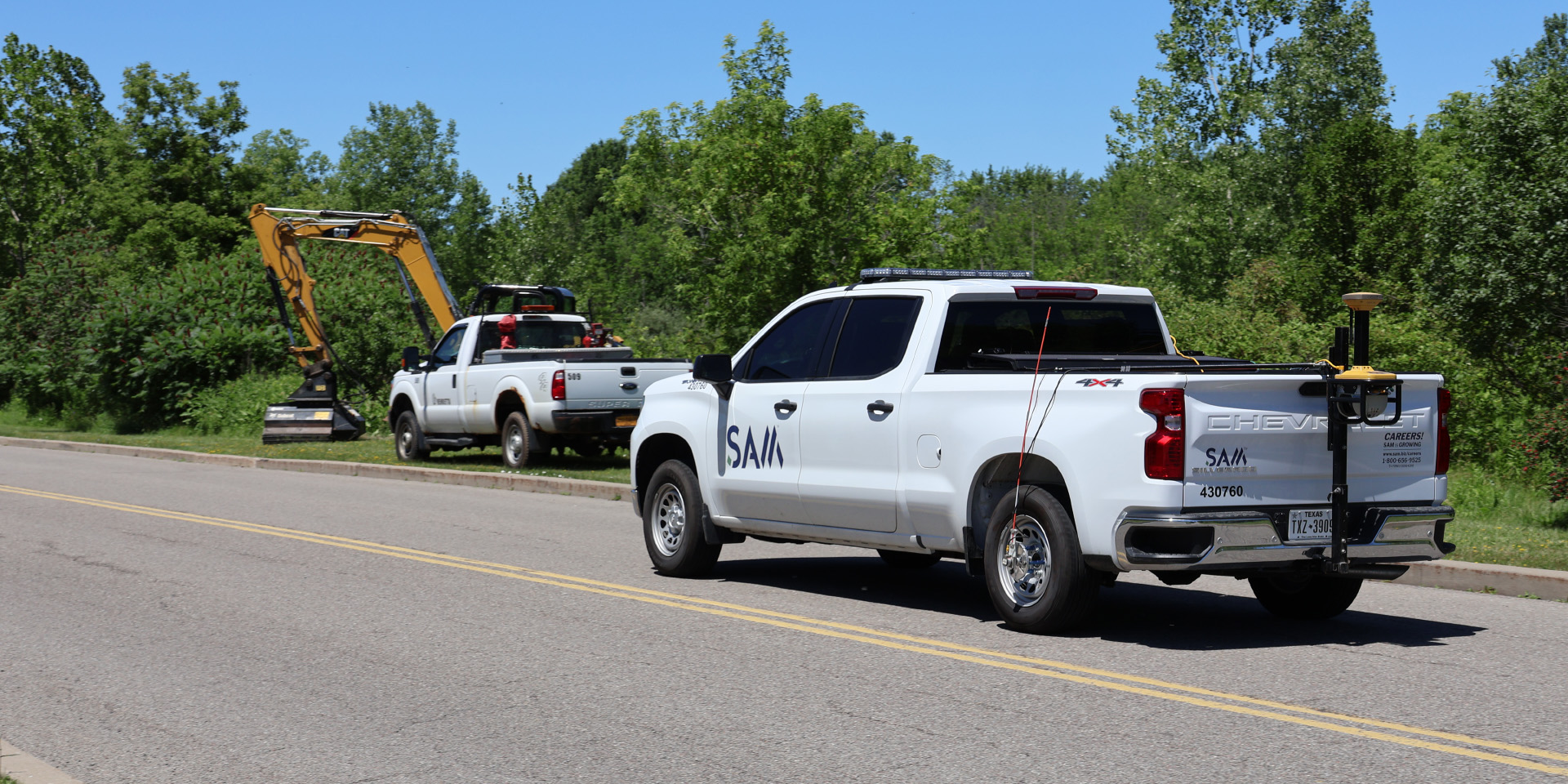Since its inception in the 1960s, GdB Geospatial has been a major presence in the northeast, known for its strengths in surveying and mapping, GIS, corridor mapping, subsurface utility work, and more. Several years back, looking to expand its construction-related services and seeing a good deal of opportunity in the western part of the state, the company established an office in Rochester, N.Y. The move has proven downright prescient: in addition to its traditional survey workload, that location has provided digital modeling and support for countless road, building and airport projects. It has done so through the efforts of a steadily growing, committed staff — a team that is also driven to using the best technology available. At the heart of many of their successful projects is an embrace of GNSS-based technology to generate valuable data, a benefit that, by nature of its speed, accuracy and ability to often improve onsite safety, has struck a chord with its clients. Using the latest tools? That’s power in its own right.
Using new technology, survey firm expands its capabilities.
Growing Gains
After GdB Rochester’s initial startup, one of its early hires to staff the survey function was Justin Roloson. A seasoned, licensed area surveyor, he joined GdB with some very specific goals in mind, one of which was to use every means available to him and his colleagues to grow the business.
“I knew coming in, based on GdB’s corporate philosophy and past practice, that they placed a lot of credence in technology,” he said. “That was a huge motivation for me to take the position — and I was not disappointed. Shortly after coming on board, we were able to tout our modeling strengths as a tool for targeting construction-related work. The strategy was successful; we were quickly landing more — and bigger — projects as a result of our modeling expertise.”
GdB’s timing could not have been better, as the Rochester area was seeing growth in the education, healthcare and business sectors, leading to a demand for survey-related services as those areas developed. “Management also saw that projects were shifting into more of a design/build focus,” said Roloson. “It was obvious we were on the right path.”

“We were soon finding that the data we generated could be a valuable asset for our growth and our clients’ success. In fact, in the last couple years, the slipform paving market has been one of the largest growing modeling markets we serve.”
– Justin Roloson
Tapping New Tech
With momentum on their side, GdB focused on further expanding their capabilities; the addition of Dave Zuber played to that strategy nicely. After spending time both in the field and building models, Zuber quickly showed a preference — and a knack — for working with slipform paving customers.
“That — and the addition of a key GPS-based solution in 2019 — helped us gain a reputation within that market as a valued tech partner,” said Roloson. “We were soon finding that the data we generated could be a valuable asset for our growth and our clients’ success. In fact, in the last couple years, the slipform paving market has been one of the largest growing modeling markets we serve.”
He added that they are seeing a change in the mindset of customers, a change reminiscent of that which occurred when GPS was first addressing the earthwork market. At that time, the prevailing consensus was that machine control was only applicable for large projects. “The same thing is happening right now with regard to employing a digital model for a job site,” said Roloson. “While the data we supply is useful for a customer doing a large subdivision, we are also seeing it paying dividends for smaller retail and chain commercial work. When any customer can use data in multiple disciplines, it increases their efficiency.”
Addressing the Workflow
While teeming with survey talent, GdB is not lacking in the instrument department either. The company’s current inventory includes three Sokkia robotic total stations, one Topcon total station, three Sokkia GNSS receivers, one Topcon GNSS receiver, and four ruggedized field computers. Neither are they lacking in support for those solutions, having a solid relationship with Admar Positioning Solutions, the local Topcon and Sokkia dealer. “Admar’s customer service is always top notch and the turnaround if any repair is needed is quick,” said Roloson. “We recently had a total station start acting up on an airport project, and a tech from Admar drove a rental out and picked ours up for repair. Total down time less than an hour!”
On the software side of the equation, Roloson said they have relied heavily on the Topcon MAGNET suite of products — particularly the Office, Field, and Collage components. “Using MAGNET in the field is easy and intuitive — the company did a great job of making it intuitive. It’s like they asked: ‘What do people need, what is it that they need to accomplish on site?’ And they built that it in.”
“The RD-M1 virtually eliminates that headache by taking a 3D laser scan of the desired surface using a vehicle moving at traffic speeds. Manual survey, which is far more labor intensive and puts personnel at risk in traffic, is eliminated — along with the need for closures.”
– Dave Zuber
Keeping it Open
That “key” solution not mentioned in the inventory list above, is a Topcon RD-M1 mobile laser scanner, which allows for fast, safe, highly accurate surface scanning in advance of applications such as milling and paving. A component of the Topcon SmoothRide solution, the instrument helped quickly established GdB as the go-to source in a range of projects in which closures are an issue, in particular, highways and airports.
“A closure — whether it be a lane of road, an entire highway, or an airport runway — can severely impact the cost of any job,” said Zuber. “The RD-M1 virtually eliminates that headache by taking a 3D laser scan of the desired surface using a vehicle moving at traffic speeds. Manual survey, which is far more labor intensive and puts personnel at risk in traffic, is eliminated — along with the need for closures.”
Zuber sees that practice in action regularly but cited a specific recent highway project as a textbook example of the benefits scanning can provide. Working as a subcontractor to South State General Contractors, they were brought in to scan six miles of northbound and southbound Interstate 295 in New Jersey to prove the severity of the road condition at the time.
“The project involved three lanes plus in each direction — all told, about 36 lane miles of scanning,” he said. “The huge advantage we brought was that we did it without the need to shut the highway down for traditional survey to take place. The DOT did have a rolling closure in place to avoid the risk of a distracted driver hitting our truck from behind, but we were able to maintain a 55 mph speed throughout each scanning session. We completed the entire project in six hours and had some outstanding data to present to the customer. That’s the power of the RD-M1 in a nutshell.”

But Wait, There’s More
While scanning with their RD-M1 is the more common occurrence for GdB, they can also lend their expertise to customers already using that solution. Case in point: The company’s work with O&G Industries, a Connecticut general contractor with strengths in paving.
“This actually speaks well to the value of the SmoothRide solution itself,” said Roloson. “O&G was doing a huge interstate project in Hartford, Conn., and, because they have their own RD-M1, they would do their scans from the nighttime work and send us the data. We would process it the following day and send them cross sections that they could submit to CTDOT. With approvals in hand, they would load the data into their paver running Topcon Millimeter GPS, pave for another three of four nights, then scan the next section, send us the data, and so on. It was a very efficient process with great results.”
He added that, although a contractor like O&G could easily hire someone to do what GdB was doing, the feasibility would be questionable. “Not every job O&G undertakes involves scanning, so to invest and train someone for just those projects would hardly be a cost-effective move. Instead, we fill that middle space, and it benefits both companies nicely.”
“Not every job O&G undertakes involves scanning, so to invest and train someone for just those projects would hardly be a cost-effective move. Instead, we fill that middle space, and it benefits both companies nicely.”
– Justin Roloson
Easily Fixed
At the core of what GdB brings to the table is more than just providing data; it’s about solving problems and providing workable solutions. And that, said Zuber, is where the RD-M1 gives them a leg up on other survey firms. “We were hired to do a traditional job for a nearby town on which the contractor had specific parameters,” he said. “However, they also had a design concern. Looking at a flat crown from the original paving that needed to be addressed, they asked us if a correction was possible. The RD-M1 allowed us to quickly gather the data, look at the possibilities, and offer a solution — before the contractor had to commit to any actual milling.”
Roloson said that same project immediately comes to mind because even he was apprehensive as it unfolded. “It was great to see it come together because, being a bit of an old school guy, I remember asking Dave if we could really do what they needed, and him saying: ‘Relax, we’ve got this.’ It was very cool to see that changing a cross-slope is as simple as typing it in, hitting ‘auto-update’ and seeing the SmoothRide solution do the rest.”
Although Zuber can’t recall just how much milling was ultimately needed for the resurfacing, he is certain that scanning really helped keep material costs down. “That project was upwards of three miles long and I don’t believe the contractor needed more than 100 tons of material for it — profile milling made a huge difference.”

New Horizons
An increased sense of excitement at GdB has been palpable of late, with the announcement of the company’s acquisition by SAM Companies, the nation’s largest Managed Geospatial Services organization. According to Roloson, a future that once looked undeniably bright is now literally blinding.
“Our interim title until the start of 2025 will be GdB a SAM Company, and we will be a part of their northeast region,” he said. “After meeting the new people at SAM, I see a very similar type of company in their offerings and the feel of how they do business. But there’s no denying that I am looking forward to the additional ‘horsepower’ and expertise that comes from being a part of such a large organization. From the perspective of this office, I think we will continue to build on our strengths in modeling and construction-related work — areas that obviously appealed to SAM — but I foresee a good deal of cross-training which will also make us stronger. We have the tools courtesy of Topcon and Sokkia, the support from Admar and the backing of SAM Companies. We couldn’t be happier.”

















